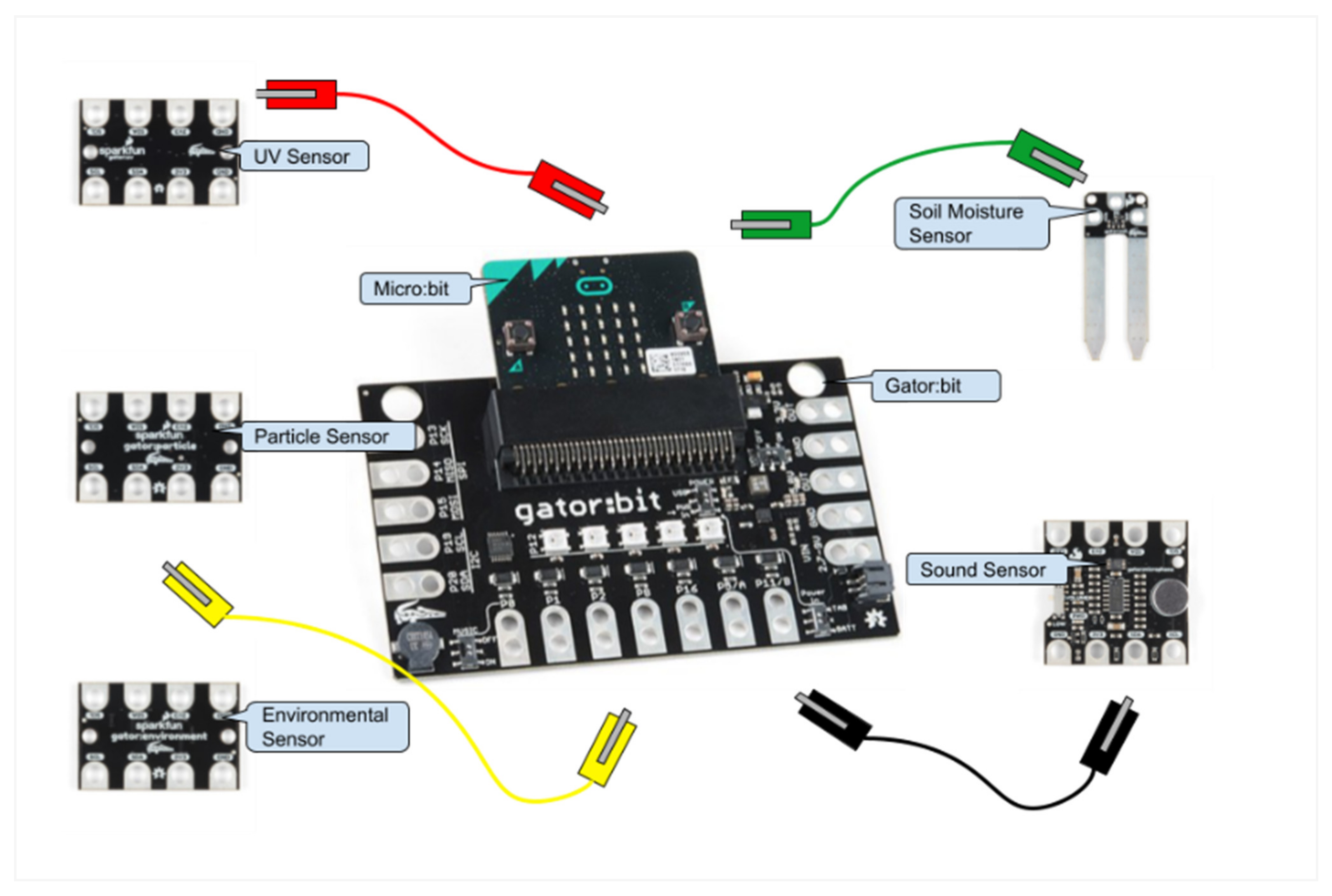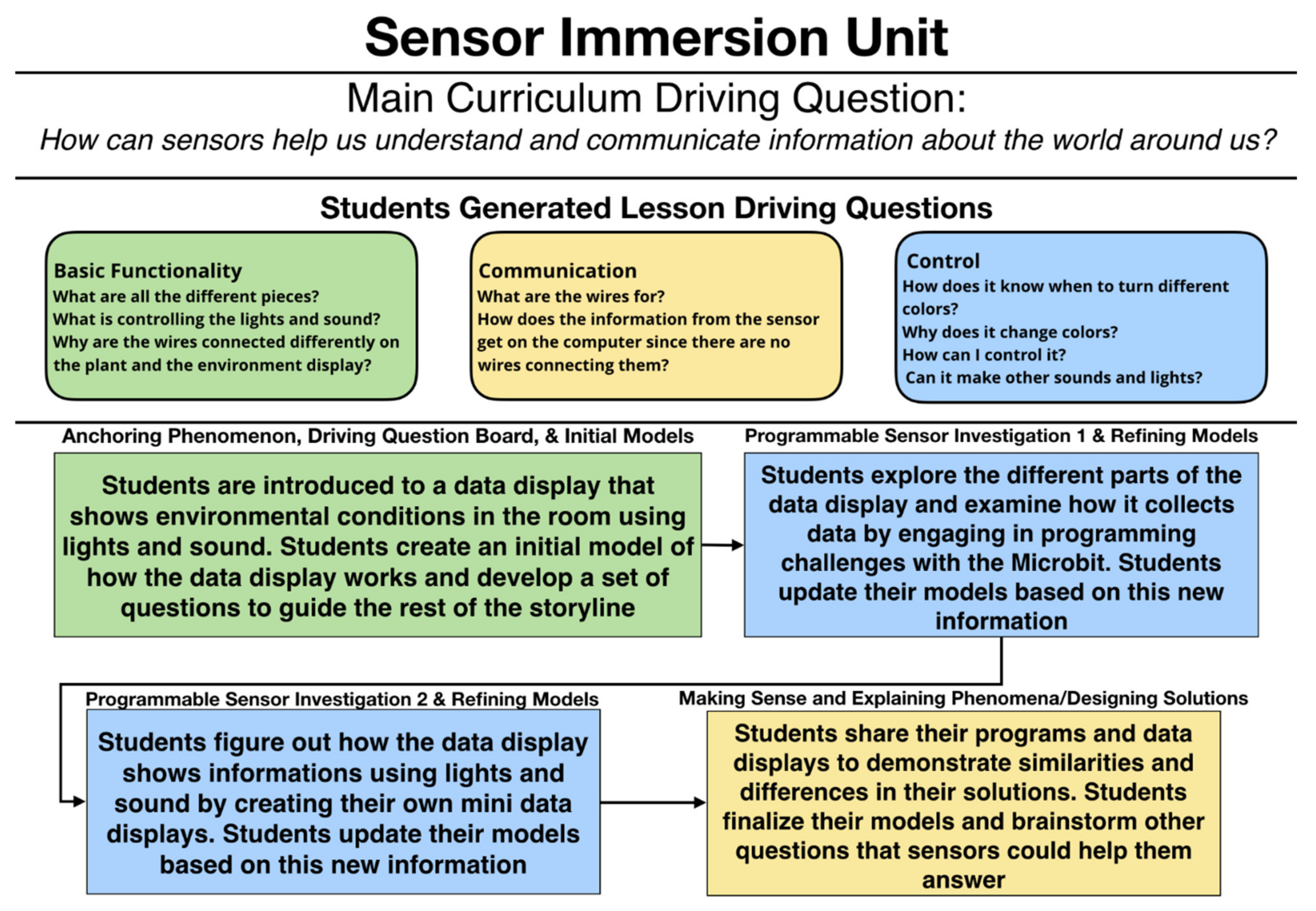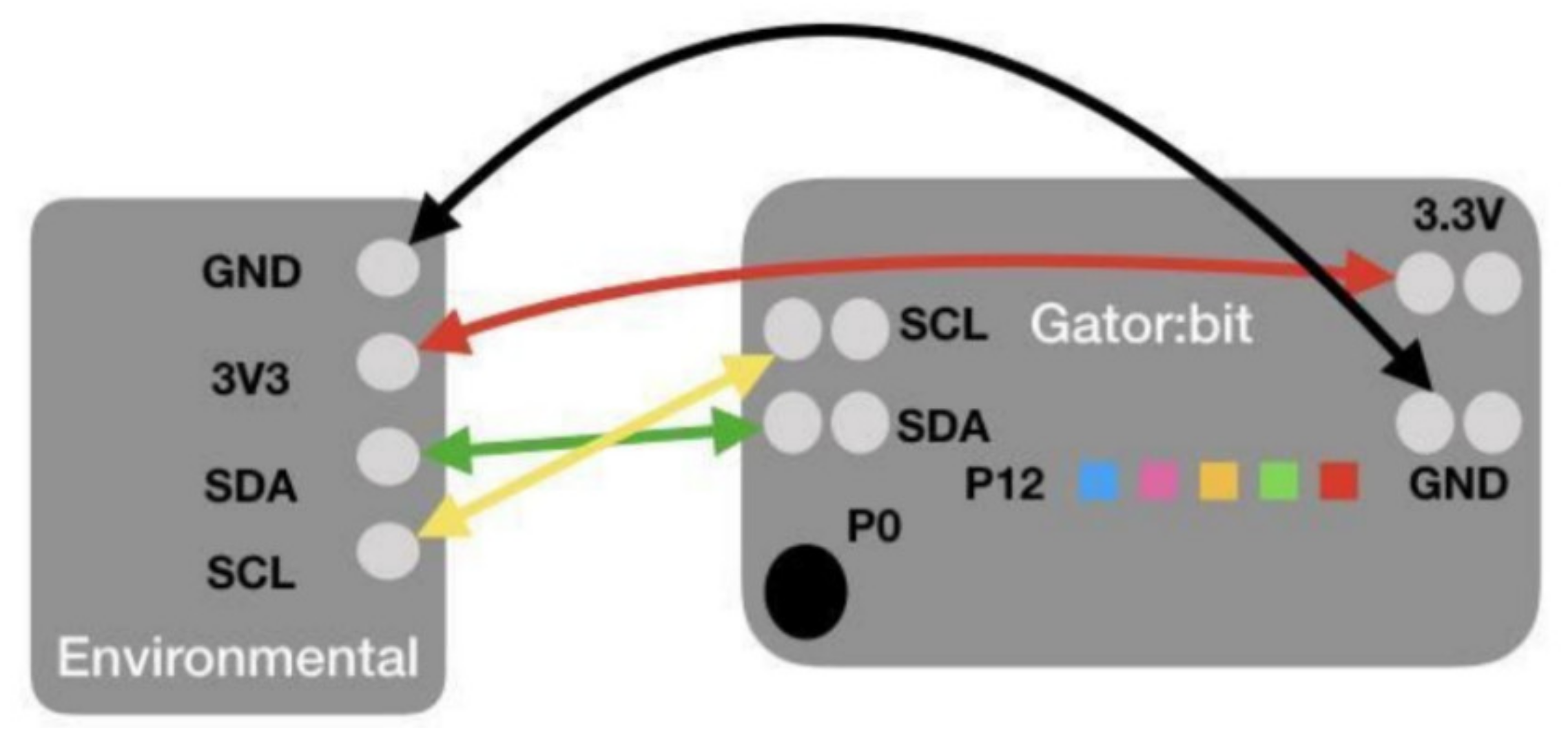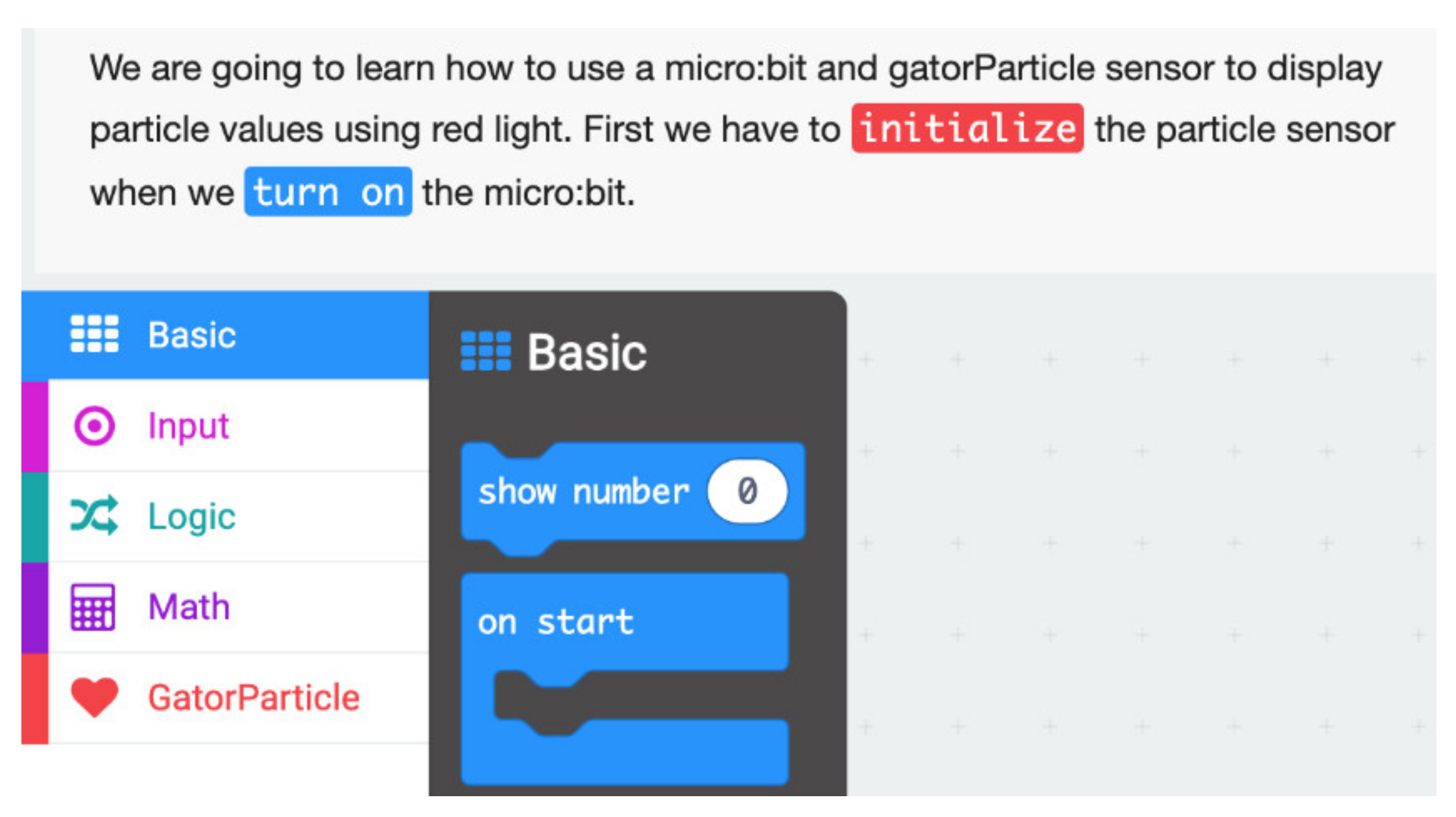1. Introduction
Advanced computing technologies have become integral to all aspects of science, technology, and engineering research and practice [
1]. One particular form of technology, sensors, is playing an increasing role in automatically detecting and recording a wide range of environmental properties. When the resulting streams of data are further processed by computers to power information displays or actuators, they are often referred to as a kind of physical computing.
Just as sensors and physical computing have revolutionized science and engineering, so too do they offer the potential for students to engage in meaningful scientific inquiry activities in ways that resemble the work of contemporary scientists [
2,
3,
4]. With growing emphasis on providing computer science education to all students [
5], these technologies also enable instructional activities that integrate computing in deep and meaningful ways. This is especially true as sensors and microcontrollers drop in price with the rise in home technology hobbyist and maker movements [
6]. Further broadening their appeal, many microcontrollers can be programmed with simple visual block-based programming languages. These drag-and-drop programming environments provide a “low floor” entry point for students, meaning novice students can more easily participate in computing and programming activities [
7].
Educational physical computing systems have the potential to expand the kinds of computing concepts students can engage in at young ages. Recent work has examined how sensors and physical computing can be integrated in instructional environments [
8,
9]. For example, DesPortes and DiSalvo [
10] studied how novices learned to program the Arduino using simple breadboarding and programming tools. Wagh et al. [
11] documented how students learn key computational practices in physical computing, specifically learning to use the hardware, software, and to debug problems across the two. Similarly, Kafai et al. [
12] studied how children learned to build and debug electronic textiles (or e-textiles) using the LilyPad Arduino and crafting materials such as conductive thread.
Finally, Hardy et al. [
13] analyze how a high school student used sensor-based tools to investigate personally meaningful science questions. They describe how the learning experiences foregrounded the use of sensors to collect data, which can highlight for students how simply collecting data involves a series of consequential decisions. In this way, it can help students learn that data collection is not a neutral act and, instead, is driven by the core needs and intentions of the investigator.
Building on this line of research, the purpose of this article is to describe a sensor-based physical computing system, called the Data Sensor Hub (DaSH), which integrates low-cost, portable, and easily programmable technologies to support students in engaging in a range of science inquiry activities.
Unlike previous work, we also designed several instructional units intended for middle school science classes that integrate use of the DaSH. These units are aligned with core science standards in the U.S., and thus, are meant to be used by a wide range of students. We summarize findings from over four years of classroom use of the DaSH and accompanying instructional units by over 30 teachers and their 3000 students in the Western United States [
14,
15,
16]. We present several themes emerging from this work, focusing on how teachers supported students in engaging in place-based inquiry learning activities while learning to use a powerful data-driven tool for scientific inquiry in ways that more closely approximate the practices of modern scientists.
2. Materials and Methods
This section details the iterative development process of the DaSH over three design cycles. The final version of the DaSH is a physical computing system that uses the BBC micro:bit to enable students to collect, analyze, and display data streams using a variety of sensors developed in conjunction with our partners at SparkFun Electronics.
2.1. The Data Senor Hub (DaSH)
Several design considerations informed decisions in selecting the components and designing the DaSH for use by middle school students. These were:
Cost: As a technology for public schools, it must be affordable.
As students will collect environmental data from many locations, the system must be portable and easily configured. Further, as students will manipulate the technology, its components must be robust.
Easily programmable by using a simple visual, drag-and-drop, block-based language. Similarly, as students gain proficiency, students have more advanced programming options available.
A variety of sensors: To support students in a range of engaging activities, a wide range of sensors must be available.
A variety of output options: Simply collecting sensor data is not sufficient. Students need means to control and visualize processed sensor data streams.
These design considerations are complex and, as with any new technology, design modifications grounded in real-world use improve its design. To this end, this section describes three versions of the DaSH, each developed as part of an iterative design cycle. After each version was tested in classrooms, researchers and teachers examined how the current version met the design criteria and recommended changes to increase alignment with the criteria. The largest change came between the first version and second versions of the DaSH when the microcontroller controlling the system was changed.
2.1.1. DaSH Version 1
Researchers, teachers and school administrators partnered with SparkFun Electronics to create a physical computing system that met the design criteria described above. For the first iteration, the design team knew it would be challenging to satisfy all the criteria, so we focused on getting a device that could collect large amounts of data from the local environment into classrooms during the first year of the project. Initially, we worked to create a custom sensor system built using an ESP32 microcontroller and i2C sensors that could be attached using 4-pin JST connectors. The microcontroller was preprogrammed by the SparkFun engineers based on feedback from the teacher partners. While this system allowed students to easily collect large amounts of environmental data from locations all over their school [
17] demonstrating robustness, it was quite expensive (~EUR 145 per kit) and it proved challenging to satisfy the additional criteria without greatly increasing the cost of an already expensive kit.
2.1.2. DaSH Version 2
Working with SparkFun Electronics, the research team and school administrators explored alternative, commercially available technology that we could modify and extend for our purposes. Designed by the BBC for use in education, we selected the micro:bit as the base microcontroller. The micro:bit has been in production since 2016, with over 5 million distributed at a cost of approximately EUR 12 per micro:bit. The micro:bit is pocket sized, thus easily transportable. For power, it requires either: (1) two AA batteries, (2) a USB connection to a computer, or (3) a power adapter connected to a wall outlet.
In terms of input, the micro:bit has two input buttons and several on-board sensors which measure light and temperature as well as a magnetometer and accelerometer. For output, it has a 5 × 5 LED light display where each LED is programmable. To expand the range of functionalities, the micro:bit can communicate with other micro:bits using radio waves to send and receive messages and data from other micro:bits. Thus, students can create a group of micro:bits that communicate information to perform different tasks (e.g., one or more micro:bits serve as data collectors that send the information to a central micro:bit for processing and display). The ability to create a network of micro:bits allows students to explore and program devices on the Internet of Things.
MakeCode [
18] serves as the programming environment for controlling the micro:bit. The open source environment is supported by Microsoft as a browser-based programming environment which enables users (students) to write programs in block and text-based languages that can be downloaded via USB onto the micro:bit’s flash memory (or via Bluetooth and the app if using a smartphone or tablet). The MakeCode environment also provides a simulation environment where students can test their code. The ability to use MakeCode in a browser removes the hurdle of installing additional software on school computers, which allows for ease of use on cloud-based computers (e.g., Chromebooks) and offers less issues when scaling up educational interventions. Considering our target audience was middle school students, the DaSH and instructional units described in
Section 3 were designed primarily to rely on block-based programming, as it provides a simple and visual entry point for students [
7]. As students become more familiar with programming concepts, they can progress to the more advanced features included in MakeCode such as the creation of arrays, functions, and even importing external extensions. In addition, they can begin the transition to the more powerful text-based programming languages, JavaScript and Python, thereby taking advantage of the “high ceiling” and “wide walls” [
19] in this programming environment.
While the micro:bit contains several onboard sensors to support data collection and LEDs to support data visualization, more sensors and actuators need to be added in accordance with the design guidelines to support a broad range of scientific investigations. Connecting a breadboard to the micro:bit could support these goals. However, implementing breadboarding activities in middle school science classes is challenging and time consuming for teachers.
2.1.3. DaSH Final Version
To create a more user-friendly expansion of the micro:bit targeted towards data collection and display, researchers and teachers continued their collaboration with SparkFun Electronics to create the gator:bit. The gator:bit makes additional pins on the micro:bit accessible for alligator clips (see
Figure 1). The use of alligator clips obviates the need for soldering or breadboarding. The gator:bit also has a speaker and 5 programmable neopixel LEDs that students can use to create displays with lights and sound.
To determine an initial set of additional sensors to add, researchers and teachers searched through available sensors and brainstormed questions about scientific phenomena that these sensors could help answer. Engineers at SparkFun Electronics then created five alligator clippable sensors, including (1) an environmental sensor that measures temperature, humidity, barometric pressure, carbon dioxide, and total volatile organic compounds, (2) a soil moisture sensor, (3) a sound sensor, (4) a UV sensor, and (5) a particle sensor (see
Figure 1). All of the sensors except the soil moisture sensor are I2C sensors and can be daisy-chained together, which enables multiple sensors to be used at one time. Each of the sensors has their own Makecode blocks so students can control the data collection process. To support the long-term collection of data, a real time clock and data logger that can save data to an SD card can also be attached to the gator:bit using alligator clips and controlled through MakeCode programs.
The DaSH can be purchased as a kit for approximately EUR 90 per kit. This is not as low cost as would be ideal, but the micro:bit and gator:bit cost EUR 28 and additional sensors can be purchased a la carte with cost ranging between EUR 4 and EUR 20, decreasing the initial cost and enabling teachers to slowly build up kits. In addition, many existing kits that provide similar functionality cost well over EUR 100 per kit (see
Table 1).
2.2. Processing and Displaying Sensor Data Streams
A key aspect of collecting sensor data streams is to address personally meaningful questions for students by processing the data to communicate, display, or visualize relevant information. Furthermore, sensor data can be processed to trigger an action in the world using the built-in speaker and a neopixel array to produce simple data displays. In this way, sensor technologies can help make the invisible visible in what can be particularly powerful learning moments for students.
Figure 2 shows three examples, created by participating teachers, where data are collected from the sensors, processed, and displayed using the micro:bit and gator:bit display and a neopixel LED strip. In the image on the left (
Figure 2a), the micro:bit is programmed to measure the moisture in the soil of a plant. The strip of 60 LEDs monitors the moisture with more lights indicating a higher percentage of moisture in the soil. When the moisture falls below a certain percentage, the speaker on the gator:bit plays a tone.
The center image (
Figure 2b) depicts a micro:bit that is programmed to control one neopixel for each sensor value (sound, temperature, humidity, barometric pressure, carbon dioxide, and total volatile organic compounds). The neopixel is green when the value is within the acceptable range, the neopixel is blue if the value is below the acceptable range, and the value is red if it is above the acceptable range. The teacher who created this chose the acceptable range values based on research and her personal preference. When button A on the micro:bit is pressed, the exact temperature scrolls across the micro:bit LEDs and when button B is pressed, the exact humidity scrolls across the micro:bit LEDs.
In the image on the right (
Figure 2c), the micro:bit was programmed to communicate information about four environmental conditions (temperature, humidity, carbon dioxide level, and sound level) using a strip of 30 LED lights and the 5 by 5 LED light array on the micro:bit. The LED lights on the micro:bit display the variable being measured by showing a letter (e.g., T for temperature) followed by the actual value recorded by the sensor. Each environmental condition is programmed to have its own color associated with it (e.g., blue for humidity) and the strip of 30 LEDs lights up so that as the value of the environmental condition increases, more LED lights are lit to indicate this increase. Additionally, if a predetermined threshold is reached, such as when the noise in the classroom reaches a certain level, the LED light strip blinks.
These displays (
Figure 2) represent just a few ways that the DaSH can be used to collect, process, and display data streams. Students can explore this functionality to tell stories with their data and use it to create visual representations of scientific phenomena.
4. Classroom Experience Findings
Over the course of four years of classroom implementations, we examined how over 30 teachers used the DaSH and the instructional units with over 3000 students. In our investigations, we collected a range of data sources, including teacher surveys, video recordings of classroom experiences, student and teacher interviews, and artifacts created by students. Several themes that emerged across analyses of these data include:
How students come to understand and think about sensors as a powerful data-driven tool for scientific inquiry through an analysis of their hand-drawn models;
How the instructional context naturally led to problems and bugs as students tinkered with the DaSH and teachers’ approaches supported students in solving them;
How the DaSH and instructional units supported meaningful place-based inquiry for students.
4.1. Exploring How Students Think about the DaSH through Hand-Drawn Models
A key component of the Sensor Immersion Unit involves students creating hand-drawn models of the DaSH. Prior research illustrated how these models can help teachers learn how their students are thinking about the topic [
26]. Including this modeling component in the Sensor Immersion Unit provides an opportunity for teachers and researchers to see the big ideas that students are taking away from their initial work with the DaSH.
We completed an analysis of 213 student models from 4 middle school science classrooms [
14]. The analysis began with our teacher partners examining a subset of the models to identify themes in students’ thinking, designed after work carried out in [
14]. The subset represented the range of student-created models: from extreme detail to something akin to a drawing. The teachers identified four main ideas represented in the models: (1) the components of the DaSH, (2) the flow of information within the DaSH and between the environment and the DaSH, (3) descriptions of how the information was displayed and (4) description of how programming affects the DaSH. The researchers then created and validated a coding scheme to examine the depth to which students engaged with these themes in their models.
The flow of information and programming representations were especially challenging for students, with fewer than 15% describing thinking around these topics [
14]. Even though few students engaged with these topics in their model, they all did successfully build their own data displays using a working understanding of the flow of information and programming. The results from this study influenced our revisions and modifications made to the Sensor Immersion Unit to further highlight the importance of the flow of information and programming as well as how to use models to express ideas beyond typical scientific phenomena that students investigate in their science classrooms. These modifications included additional professional learning activities where teachers created incremental models of the DaSH and new teacher guides that provide support for teachers to implement and use student models to guide their instruction and student inquiry.
4.2. Debugging and Troubleshooting
As students assemble their DaSHs, they inevitably run into problems where it does not perform as they expect and they need to debug it to achieve the desired performance. Thus, as a fundamental part of using sensors and data-driven tools for scientific inquiry, students need to learn to troubleshoot and debug.
Teachers also need to learn to support students in troubleshooting and debugging the DaSH when they implement these units in their classes. This can be challenging for teachers as they are often new to the tools themselves.
To support students in learning these skills, the curricula provide wiring diagrams (
Figure 6) that illustrate how to assemble the DaSH as well as programming tutorials (
Figure 7). The MakeCode tutorials reduce the blocks students can access to a subset of all the blocks available and include color-coded hints to reduce the cognitive load required to figure out what block to use and where to find them. However, even with these scaffolds, students encounter bugs as they try to decide which blocks to use and program different actions with the DaSH. These bugs arise from issues with the hardware, software, and the bridge between them.
Our analysis of classroom experiences revealed common bugs faced by students, which we classified into three categories: hardware (HW), software (SW) and the intersection between the two (HW + SW) [
10] (see
Table 2). In teacher professional development sessions, we include targeted time where we highlight these common bugs and discuss strategies for helping students work through them.
Our analyses of classroom experiences also revealed the different ways teachers supported students during troubleshooting and debugging episodes. Analyses highlight three necessary practices for debugging and troubleshooting the DaSH: noticing there is an issue, finding the source of the issue, then fixing it. Therefore, helping students develop debugging skills also means helping them understand the connections between the DaSH’s operation, the hardware, and the software to diagnose when their expectation of the system (often connected to their programming logic) does not align with its output.
In interviews and professional development discussions, teachers talked about the different ways that students persisted (or not) when engaged in troubleshooting and debugging. For example, one teacher noted that her traditionally lower achieving class was much more successful than her traditionally higher achieving class in achieving the learning goals of the Sensor Immersion Unit because they were much better at working through mistakes and bugs. She shared that she needed to keep reminding her traditionally higher achieving class: “that’s kind of how you get to it to the end result… asking questions, making mistakes, troubleshooting, working with your group.” She also noted that her higher achieving students would become “nervous” when they did not know the right answer. Other teachers agreed that using the DaSH in their classrooms appropriately required ample time and motivation for students to tinker with and debug their systems to make them work.
4.3. Support for Place-Based Investigations
One purpose the DaSH serves is to support students to collect and analyze meaningful data from their environment, with the goal of getting them to ask the “so what” and “why here” questions. We have seen teachers uptake this goal in unique ways. For example, one teacher used the data display that anchored the Sensor Immersion Unit as evidence for getting more fans in her classroom during an early September heat wave (14). She described to one of the researchers during a classroom visit that she had shown her principal how the lights were blinking for the temperature reading (indicating that the temperature was over 30 degrees Celsius). Once she received the fans, she told her students how she had used the DaSH to make their room more comfortable, inspiring them to examine how to use the sound sensor to monitor the classroom noise level for their individual displays.
During remote learning, due to the COVID-19 pandemic, several teachers distributed DaSHs to their students and conducted the Sensor Immersion Unit synchronously online. This allowed students to use the sensors to explore their homes and ask questions about why one student’s house was hot or cold or why there were higher than average carbon dioxide levels. In addition, one teacher encouraged her students to connect the battery packs to the micro:bit and explore their entire home and surrounding areas. Students created metal detectors using the magnetometer sensor on the micro:bit to search for items with strong magnetic fields. This led to quite an engaging conversation in the chat where students posted about the maximum possible magnetic reading they could find [
16].
These examples illustrate how students are able to make personal connections with the data and use the DaSH to create displays that they can use to support their arguments. These are key aspects of being an informed consumer in this increasingly data-driven world.
5. Discussion and Conclusions
This article describes a sensor-based physical computing system (DaSH) using low-cost, portable, and accessible micro:bit/gator:bit microcontrollers. The system can be programmed to create information displays to introduce students to computing-infused scientific inquiry in ways that more closely resemble contemporary scientific practices. We also described two inquiry-oriented instructional units (Sensor Immersion and Composting Ecosystems) that guide students in learning to design the automated collection, processing and display of environmental data to address personally meaningful questions about the world around them. Finally, we described three major themes that emerged during analyses of participating teachers’ learning and classroom experiences.
As the sensor-based system and instructional units all cover content and pedagogy that is new to most middle school teachers, we have developed robust accompanying materials and activities for teacher professional development, called the CT-Integration cycle [
23]. We have also conducted several empirical studies of student learning in the context of these units [
14,
17].
Implementing the physical computing software described above addresses an important need in students’ middle school science experiences. It offers an opportunity for integrated experiences in (1) computing, (2) engineering and (3) scientific processes by engaging students in the programming, wiring, and use of sensors that can help them interpret the world around them. Units were developed, and continue to be iterated, grounded in the fundamental concepts of project-based learning [
27,
28] that encourages longer, personally relevant, learning activities for students.
The DaSH and instructional units are intended to be adaptable to different middle school science teaching contexts. They are also opportunities for integrating computational thinking into science and technology classrooms. These experiences offer students opportunities to deeply engage with and understand the use and production of large streams of data [
14]. In this way, this new educational technology creates opportunities for students to demystify sensor data, scientific data, and data streams in general by giving students the opportunity to engage in their production, analysis, and communication. By planning, debugging, and modeling their use of the DaSH, students learn to take ownership of the sensor data they collect and are able to collect data relevant to their lived experiences.













